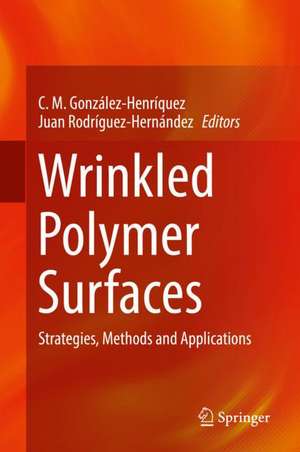Wrinkled Polymer Surfaces: Strategies, Methods and Applications
Editat de C. M. González-Henríquez, Juan Rodríguez-Hernándezen Limba Engleză Hardback – 26 feb 2019
- Presents a detailed description of the physical phenomena and strategies occurring at polymer surfaces to produce wrinkled surface patterns;
- Examines the different methodologies to produce morphology-controlled wrinkled surface patterns by means of physical and chemical treatment methods;
- Provides clear information on current and potential applications in flexible electronics and biomaterials, which are leading the use of these materials.
Preț: 954.45 lei
Preț vechi: 1163.97 lei
-18% Nou
Puncte Express: 1432
Preț estimativ în valută:
182.63€ • 191.20$ • 151.12£
182.63€ • 191.20$ • 151.12£
Carte tipărită la comandă
Livrare economică 07-21 aprilie
Preluare comenzi: 021 569.72.76
Specificații
ISBN-13: 9783030051228
ISBN-10: 3030051226
Pagini: 440
Ilustrații: XIV, 362 p. 215 illus., 180 illus. in color.
Dimensiuni: 155 x 235 mm
Greutate: 0.7 kg
Ediția:1st ed. 2019
Editura: Springer International Publishing
Colecția Springer
Locul publicării:Cham, Switzerland
ISBN-10: 3030051226
Pagini: 440
Ilustrații: XIV, 362 p. 215 illus., 180 illus. in color.
Dimensiuni: 155 x 235 mm
Greutate: 0.7 kg
Ediția:1st ed. 2019
Editura: Springer International Publishing
Colecția Springer
Locul publicării:Cham, Switzerland
Cuprins
Chapter1: Introduction to surface instabilities and wrinkle formation.- Chapter2: Strategies for the fabrication of wrinkled surfaces.- Chapter3: Wrinkles obtained by frontal polymerization/vitrification.- Chapter4: Control of the wrinkled structure on surface-reformed elastomers via ion-beam bombardment.- Chapter5: Wrinkle formation by interfacial swelling on thermoplastic surfaces.- Chapter6: Laser-induced periodic surface structures (LIPSS) on polymer surfaces.- Chapter7: Design of perfectly ordered periodic structures on polymers using Direct Laser Interference Patterning.- Chapter8: Micro- and nano-patterned hydrogels fabricated by taking advantage of surface instabilities.- Chapter9: Wrinkling on covalently-anchored hydrogels.- Chapter10: Ripples and Wrinkles in graphene-Beyond continuum mechanics.- Chapter11: Wrinkling Labyrinth Patterns on Elastomeric Janus Particles.- Chapter12: Wrinkled surfaces designed for bio-related applications.- Chapter13: Tuning Surface Morphology of Polymer Films through Bilayer Structures, Mechanical Forces and External Stimuli.- Chapter14: Other applications of wrinkled polymer surfaces.- Chapter15: Summary and futures outlooks.
Notă biografică
Dr. Juan Rodriguez-Hernandez is a tenured researcher at the Institute of Polymer Science and Technology – Spanish National Research Council, specializing in the preparation of micro and nanostructured polymer surfaces and focusing on polymer blends.
Dr. Carmen González Henríquez is an associated professor at the Universidad Tecnológica Metropolitana (UTEM) in Chile. Her research interests are focused on the design and fabrication of smart polymers, particularly hydrogels, on the generation of biomimetic phospholipid bilayer membranes and on finding alternative design methods for material surface architectures.
Dr. Carmen González Henríquez is an associated professor at the Universidad Tecnológica Metropolitana (UTEM) in Chile. Her research interests are focused on the design and fabrication of smart polymers, particularly hydrogels, on the generation of biomimetic phospholipid bilayer membranes and on finding alternative design methods for material surface architectures.
Textul de pe ultima copertă
This book presents the state of the art in surface wrinkling, including current and future potential applications in biomedicine, tissue engineering, drug delivery, microfluidic devices, and other promising areas. Their use as templates, flexible electronics, and supports with controlled wettability and/or adhesion for biorelated applications demonstrate how the unique characteristics of wrinkled interfaces play a distinguishing and remarkable role. The fabrication approaches employed to induce wrinkle formation and the potential to fine-tune the amplitude and period of the wrinkles, their functionality, and their final morphology are thoroughly described. An overview of the main applications in which these buckled interfaces have already been employed or may have an impact in the near future is included.
- Presents a detailed description of the physical phenomena and strategies occurring at polymer surfaces to produce wrinkled surface patterns;
- Examines the different methodologies to produce morphology-controlled wrinkled surface patterns by means of physical and chemical treatment methods;
- Provides clear information on current and potential applications in flexible electronics and biomaterials, which are leading the use of these materials.
Caracteristici
Presents a detailed description of the physical phenomenon and the strategies occurring at polymer surfaces to produce wrinkled surface patterns Examines the different methodologies to produce morphology-controlled wrinkled surface patterns by means of physical and chemical treatment methods Provides clear information on the current and potential applications in flexible electronics and biomaterials, which are leading the use of these materials
